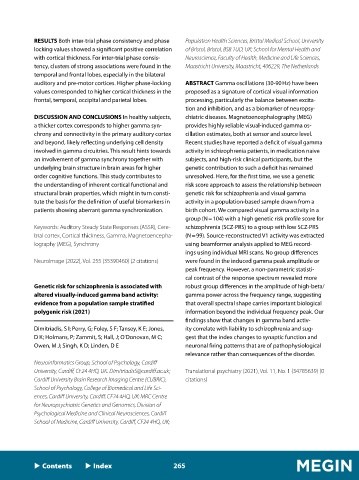Page 286 - MEGIN Book Of Abstracts - 2023
P. 286
RESULTS Both inter-trial phase consistency and phase Population Health Sciences, Bristol Medical School, University
locking values showed a significant positive correlation of Bristol, Bristol, BS8 1UD, UK; School for Mental Health and
with cortical thickness. For inter-trial phase consis- Neuroscience, Faculty of Health, Medicine and Life Sciences,
tency, clusters of strong associations were found in the Maastricht University, Maastricht, 406229, The Netherlands
temporal and frontal lobes, especially in the bilateral
auditory and pre-motor cortices. Higher phase-locking ABSTRACT Gamma oscillations (30-90 Hz) have been
values corresponded to higher cortical thickness in the proposed as a signature of cortical visual information
frontal, temporal, occipital and parietal lobes. processing, particularly the balance between excita-
tion and inhibition, and as a biomarker of neuropsy-
DISCUSSION AND CONCLUSIONS In healthy subjects, chiatric diseases. Magnetoencephalography (MEG)
a thicker cortex corresponds to higher gamma syn- provides highly reliable visual-induced gamma os-
chrony and connectivity in the primary auditory cortex cillation estimates, both at sensor and source level.
and beyond, likely reflecting underlying cell density Recent studies have reported a deficit of visual gamma
involved in gamma circuitries. This result hints towards activity in schizophrenia patients, in medication naive
an involvement of gamma synchrony together with subjects, and high-risk clinical participants, but the
underlying brain structure in brain areas for higher genetic contribution to such a deficit has remained
order cognitive functions. This study contributes to unresolved. Here, for the first time, we use a genetic
the understanding of inherent cortical functional and risk score approach to assess the relationship between
structural brain properties, which might in turn consti- genetic risk for schizophrenia and visual gamma
tute the basis for the definition of useful biomarkers in activity in a population-based sample drawn from a
patients showing aberrant gamma synchronization. birth cohort. We compared visual gamma activity in a
group (N = 104) with a high genetic risk profile score for
Keywords: Auditory Steady State Responses (ASSR), Cere- schizophrenia (SCZ-PRS) to a group with low SCZ-PRS
bral cortex, Cortical thickness, Gamma, Magnetoencepha- (N = 99). Source-reconstructed V1 activity was extracted
lography (MEG), Synchrony using beamformer analysis applied to MEG record-
ings using individual MRI scans. No group differences
NeuroImage (2022), Vol. 255 (35390460) (2 citations) were found in the induced gamma peak amplitude or
peak frequency. However, a non-parametric statisti-
cal contrast of the response spectrum revealed more
Genetic risk for schizophrenia is associated with robust group differences in the amplitude of high-beta/
altered visually-induced gamma band activity: gamma power across the frequency range, suggesting
evidence from a population sample stratified that overall spectral shape carries important biological
polygenic risk (2021) information beyond the individual frequency peak. Our
findings show that changes in gamma band activ-
Dimitriadis, S I; Perry, G; Foley, S F; Tansey, K E; Jones, ity correlate with liability to schizophrenia and sug-
D K; Holmans, P; Zammit, S; Hall, J; O'Donovan, M C; gest that the index changes to synaptic function and
Owen, M J; Singh, K D; Linden, D E neuronal firing patterns that are of pathophysiological
relevance rather than consequences of the disorder.
Neuroinformatics Group, School of Psychology, Cardiff
University, Cardiff, CF24 4HQ, UK. DimitriadisS@cardiff.ac.uk; Translational psychiatry (2021), Vol. 11, No. 1 (34785639) (0
Cardiff University Brain Research Imaging Centre (CUBRIC), citations)
School of Psychology, College of Biomedical and Life Sci-
ences, Cardiff University, Cardiff, CF24 4HQ, UK; MRC Centre
for Neuropsychiatric Genetics and Genomics, Division of
Psychological Medicine and Clinical Neurosciences, Cardiff
School of Medicine, Cardiff University, Cardiff, CF24 4HQ, UK;
ontents Index 265
C

